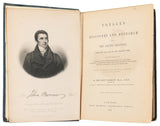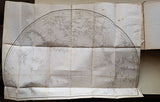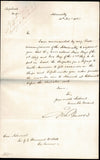Voyages of Discovery and Research within the Arctic Regions, from the Year 1818 to the Present Time: Under the Command of the Several Naval Officers . in Search of a Northwest Passage from the Atlantic to the Pacific; with two attempts to reach the Pole
Author: John Barrow (1764-1848) with a handwritten letter by the author
Year: 1846
Publisher: John Murray
Place: London
Description:
xiv+[1]-53+[16 ad] pages with Illustrated with frontispiece portrait and 2 maps (one folding) Octavo (9" x 6") bound in original publisher's full blue cloth, decoratively paneled in blind, spine stamped in gilt, later yellow endleaves. With one page letter from John Barrow to Rear Admiral Sir G E Hammond. (Arctic Bibliography 1096) First edition.
Contains a detailed account of the principal British expeditions into the North American Arctic (also to Svalbard), from that of Ross in 1818 to those of Back and Simpson, 1836-39; their scientific achievements, and contribution towards a discovery of a Northwest Passage. The final chapter includes criticism of Sir John Ross' second voyage 1829-33, to which Ross replied in his Observations on a Work by Sir John Barrow (1846).
Sir John Barrow, 1st Baronet, was an English geographer, linguist, writer and civil servant best known for serving as the Second Secretary to the Admiralty from 1804 until 1845. Barrow was appointed Second Secretary to the Admiralty by Viscount Melville, a post which he held for forty years. In his position at the Admiralty, Barrow was a great promoter of Arctic voyages of discovery, including those of John Ross, William Edward Parry, James Clark Ross and John Franklin. Barrow Strait, Cape Barrow, and Cape John Barrow in the Canadian Arctic, as well as Point Barrow and the former city of Barrow in Alaska are named after him. Letter (one page 7.75 x 12.5" dated November 26, 1835) to Rear Admiral Sir G. E. Hammond, in full: "I am commanded by my Lords Commissioners of the Admiralty to acquaint you, that they have ordered Nine Boys of the 1st Class and Two Boys of the 2nd Class to be put on board the Cleopatra for a Passage to South America to fill vacancies in the Ships and Vessels under your orders provided the number can be obtained at Portsmouth before the Cleopatra sails."
Condition:
Skillfully recased, spine sunned and chipped, some sunning and rubbing to board edges, corners bumped, hinges cracked, some toning, occasional wrinkling to text, some creasing to maps, several leaves unopened else very good. Letter near fine













